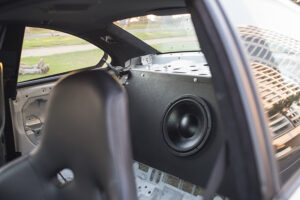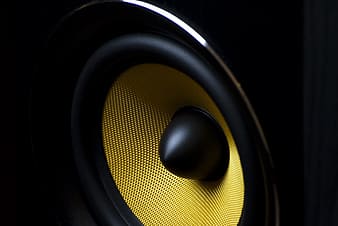Free air subwoofers don’t require a mounting enclosed space to work productively. In a free-air arrangement, subwoofers are normally mounted either in the back deck or appended to a board set between the secondary lounges of a vehicle and the storage compartment.
This board makes an impenetrable seal and transforms the whole trunk into a walled-in area – this is otherwise called infinite baffle (IB) structure. Most of the time these words are used interchangeably.
Utilizing a free air subwoofer is good for applications where trunk space is less. It’s generally the easiest to use and most economical approach to add some bass in your car audio music, without surrendering your valuable trunk space for a mammoth subwoofer stand.
Since free air subs, don’t have a walled-in area, they won’t occupy a lot of space in your vehicle and can be mounted (in certain applications) where they may not be visible in any way.
Free Air Subwoofer Features To Look For
It should be noted that while being very useful, utilizing a free-air subwoofer may bargain sound quality, in any event somewhat. A free-air subwoofer won’t sound using any means in the same class as a subwoofer mounted in a cautiously structured walled-in area.
Also, anything that you place in the storage compartment may forestall the sub(s) to sound in the same class as it was intended to, which might be a burden to the general utilization of one’s vehicle.
One thing to remember is that when you’re mounting a sub or a few subs in your back deck you may need to change some seating requirements.
Its usually recommended to utilize some stifling material like Dynamat or Hushmat in the storage compartment so there can be seen as signs of improvement in sound execution.
In this article, it will also be discussed what is the difference between an infinite buffer arrangement and a free air subwoofer, and if they are the same thing.
In any case, in an infinite buffer arrangement, the front and back waves are disengaged so they don’t meddle with one another, while In a free-air arrangement, front and back waves have some association.
A few people utilize the two terms reciprocally, and there’s nothing amiss with that.
Infinite Baffle Back Seat Installation

Not building a nook/box for your subwoofer is more preferable.
In any case, since free air subwoofers utilize the entire trunk as a crate, the storage compartment must be as fixed as conceivable from the lodge with the goal that the sound waves from the back of the speaker cant arrive at the front of the speaker to cause crossing out.
In this way, your vehicle may require another back deck board as well as a vent to be developed to accommodate these woofers.
P.S: These custom vents and boards could cost as much as a pre-assembled or custom box.
Free Air Sub against infinity Baffle
“Is Infinite Baffle and Free-Air something very similar?” is a typical inquiry that comes now and then. The appropriate response is that they are not something very similar, however, they can be termed as closely related.
Basically, a free air sub is a speaker intended to sound well without the utilization of a closed area. It’s worked to be mounted in the back deck of a vehicle, for instance, while, sounding great. Infinite baffle can be as straightforward as a board or mounting surface which is called a baffle.
This can be a level MDF board with your free air sub mounted to it and afterward joined to the back of the seat of a car. Numerous vehicles out there have at any rate one subwoofer mounted in the back bundle plate boundless astound directly by the full-range speakers.
With this kind of mounting, the vehicle trunk is normally utilized as a walled-in area. In any case, It must be noticed that when mounting your subwoofers in an infinite buffer arrangement, you should have a woofer that is equipped for working in a baffle.
Moreover, you have to ensure that you seal the mounting astound tantamount to conceivable to forestall the back influxes of the speaker (produced from the rear of the subwoofer cone) from counteracting the front ones.
A free air sub mounting can be a genuine test because of the potential trouble of fixing off the front and back of the baffle.
Remember that bass (low frequencies) can without much stretch travel through whatever isn’t strong enough, for example, the back seat froth/cowhide. Any territories not fixed enough between the front and back of the astound will diminish the measure of bass
Since free air subs aren’t intended to be mounted in a crate, there is only the suspension of the woofer to control cone development.
That is the motivation behind why it actively suggested that you decide on an amplifier that has a subsonic channel to sift through and weaken frequencies so low that your
The subwoofer can’t imitate.
Moreover, air-free subs mounting limits the all-out yield of the woofer and its capacity of power. That is the reason it is ideal to utilize a woofer explicitly intended for this kind of mounting arrangement.
Following are some of the main free air subwoofer pros and cons:
Pros
The baffle system framework is basic and simple to assemble.
Easy installation on a baffle board ( no fully closed area)
Smooth frequency reaction
Doesn’t occupy a lot of space in the trunk
Utilizes speakers’ characteristic frequency roll-off
Cons
Isolating back waves from front waves is tough
Constrained handling of power
Constrained yield
Requires a speaker with a subsonic channel (obligatory)
The storage compartment must be fixed from the lodge
Types of Free Air Subwoofers Application
There are different approaches to mount your subwoofer using the infinite baffle method. These follow a similar idea. Which of them to utilize is dependent on your vehicle type.
Any of these could work fine and give good results in an enormous car. Similarly, a portion of these setups probably won’t perform admirably in hatchbacks.
Rear Deck Installation In Large Sedans
If you have an enormous vehicle, at that point, you’re in luck since you’ll have enough surface region to fit in a couple of shallow mount 12 subwoofers or a 15-inch shallow subwoofer.
These vehicles are the simplest to support an air-free subwoofer set-up. In any case, the storage compartment must be as fixed and sealed as much as possible from the lodge. This can be achieved by putting a thick medium to high thickness fiberboard under the deck and behind the seat.
Secondary Lounge Installation
Mounting your free air subwoofer car audio behind the secondary lounges rather than under the back deck is another sort of application. This is regularly a lot simpler and more affordable than cutting the back deck and won’t require a huge amount of adjustments to the current deck board.
Small Deck Installation
The absence of the surface zone expected to mount a huge free air woofer in the back deck is one of the most testing things with numerous advanced vehicles.
That said, you don’t need to feel disappointed if with the vehicle since it is still possible to utilize free air subwoofers by venting them through the back deck.
What Do Free Air Subwoofers Need?
Free air sub-applications need a woofer system with a bulkier suspension for high force dealing with and one with better cone damping. This set-up will be moderately less proficient at precisely recreating the most reduced frequencies.
Further, more enhancer force will be required when contrasted with a standard fixed or ported box, however on the other hand, despite everything you have a full trunk.
All things considered, a free air subwoofers arrangement is an extraordinary answer for you on the off chance that you need to add punch and nearness to your music without relinquishing the whole load zone on your vehicle.
What Are Free Air Speakers?
Free air speakers are a type of speaker that does not require an enclosure. Instead, the speaker uses the surrounding air as its enclosure.
This makes free air speakers much more lightweight and portable than other types of speakers. Free air speakers are typically used in cars, but they can also be used in homes and businesses.
What Are Open Air Subwoofer?
An open air subwoofer is a type of speaker that uses an exposed driver to produce sound.
This type of speaker is typically used in outdoor settings or in large rooms where the speakers need to be heard over a wide area. Open air subwoofers are often used in PA systems or for home theater setups.
There are several benefits to using open air subwoofers. One benefit is that they are more efficient than closed-box subwoofers. This means that they require less power to produce the same amount of sound.
Additionally, open air subwoofers have a wider frequency response than closed-box subwoofers. This means that they can reproduce low frequencies more accurately.
Finally, open air subwoofers typically have a higher sensitivity than closed-box subwoofers. This means that they can produce louder sound with less power.
Conclusion
A free air subwoofer system or an infinite baffle system is a perfect solution for those who love the state of the art sound while traveling. It takes up less space while delivering a powerful performance in terms of sound quality and bass enhancements.
There are a few drawbacks to this system as well, such as impacted performance in smaller sedans and sound interference in the absence of fiberboard. Obviously, with some money going into the privacy of a free air subwoofer, you expect it to give 100 percent.
That said, there isn’t any other installation system out there that will give such a level of amplification, the balance of bass as well as the loudness of the music.
With realistic expectations and some cleverness, a free air subwoofer system will become the investment of a lifetime which will be worth every penny.



I enjoyed reading this. Great read. Your article has proven useful to me. Nice read. Jaime Castaneda
Thanks
There is clearly a lot to realize about this. I suppose you made certain good points in features also. Lonny Sandhop